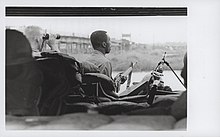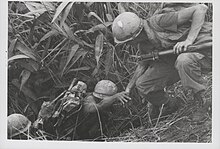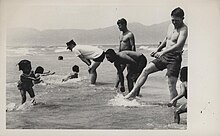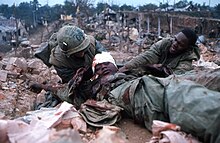
A Vietnam veteran is an individual who performed active military, naval, or air service in the Republic of Vietnam during the Vietnam War.
Desegregation is the process of ending the separation of two groups, usually referring to races. Desegregation is typically measured by the index of dissimilarity, allowing researchers to determine whether desegregation efforts are having impact on the settlement patterns of various groups. This is most commonly used in reference to the United States. Desegregation was long a focus of the American civil rights movement, both before and after the US Supreme Court's decision in Brown v. Board of Education, particularly desegregation of the school systems and the military. Racial integration of society was a closely related goal.

Red Summer was a period in mid-1919 during which white supremacist terrorism and racial riots occurred in more than three dozen cities across the United States, and in one rural county in Arkansas. The term "Red Summer" was coined by civil rights activist and author James Weldon Johnson, who had been employed as a field secretary by the National Association for the Advancement of Colored People (NAACP) since 1916. In 1919, he organized peaceful protests against the racial violence.

Opposition to United States involvement in the Vietnam War (before) or anti-Vietnam War movement (present) began with demonstrations in 1965 against the escalating role of the United States in the Vietnam War and grew into a broad social movement over the ensuing several years. This movement informed and helped shape the vigorous and polarizing debate, primarily in the United States, during the second half of the 1960s and early 1970s on how to end the war.
The "Winter Soldier Investigation" was a media event sponsored by the Vietnam Veterans Against the War (VVAW) from January 31, 1971, to February 2, 1971. It was intended to publicize war crimes and atrocities by the United States Armed Forces and their allies in the Vietnam War. The VVAW challenged the morality and conduct of the war by showing the direct relationship between military policies and war crimes in Vietnam. The three-day gathering of 109 veterans and 16 civilians took place in Detroit, Michigan. Discharged servicemen from each branch of the armed forces, as well as civilian contractors, medical personnel and academics, all gave testimony about war crimes they had committed or witnessed during the years 1963–1970.
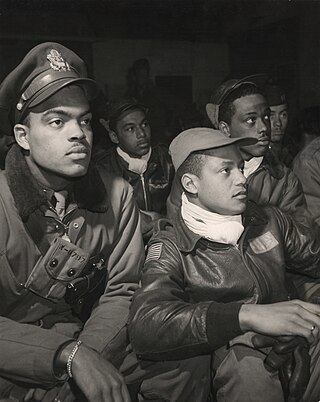
The military history of African Americans spans from the arrival of the first enslaved Africans during the colonial history of the United States to the present day. African Americans have participated in every war fought by or within the United States.

Ethnic minorities in the U.S. Armed Forces during World War II comprised about 13% of all military service members. All US citizens were equally subject to the draft, and all service members were subject to the same rate of pay. The 16 million men and women in the services included 1 million African Americans, along with 33,000+ Japanese-Americans, 20,000+ Chinese Americans, 24,674 American Indians, and some 16,000 Filipino-Americans. According to House concurrent resolution 253, 400,000 to 500,000 Hispanic Americans served. They were released from military service in 1945-46 on equal terms, and were eligible for the G.I. Bill and other veterans' benefits on a basis of equality. Many veterans, having learned organizational skills, and become more alert to the nationwide situation of their group, became active in civil rights activities after the war.
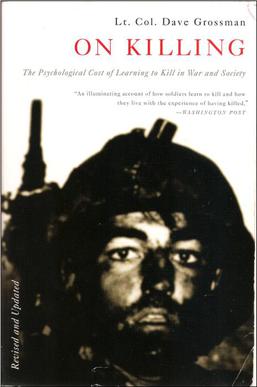
On Killing: The Psychological Cost of Learning to Kill in War and Society is a book by Dave Grossman exploring the psychology of the act of killing and the military and law enforcement establishments attempt to understand and deal with the consequences of killing. The book is based on S.L.A. Marshall's theory that the majority of soldiers in war do not ever fire their weapons due to an innate resistance to killing.
The Camp Lejeune incident refers to the outbreak of hostilities between black and white enlisted Marines at an NCO Club near the United States Marine Corps's Camp Lejeune in North Carolina, on the evening of July 20, 1969. It left a total of 15 Marines injured, and one, Corporal Edward E. Blankston, dead. It was subsequently investigated by the military and led to widespread changes in military race relations and policy.

The Memphis massacre of 1866 was a series of violent events that occurred from May 1 to 3, 1866 in Memphis, Tennessee. The racial violence was ignited by political and social racism following the American Civil War, in the early stages of Reconstruction. After a shooting altercation between white policemen and black veterans recently mustered out of the Union Army, mobs of white residents and policemen rampaged through black neighborhoods and the houses of freedmen, attacking and killing black soldiers and civilians and committing many acts of robbery and arson.

The USS Kitty Hawk riot was a racial conflict between white and black sailors aboard the United States Navy aircraft carrier Kitty Hawk on the night of 12–13 October 1972, while positioned at Yankee Station off the coast of North Vietnam during the Vietnam War.
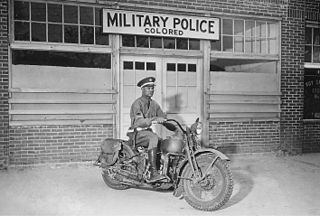
A series of policies were formerly issued by the U.S. military which entailed the separation of white and non-white American soldiers, prohibitions on the recruitment of people of color and restrictions of ethnic minorities to supporting roles. Since the American Revolutionary War, each branch of the United States Armed Forces implemented differing policies surrounding racial segregation. Racial segregation in the U.S. military was officially prohibited by Harry S. Truman's Executive Order 9981 in 1948, though unofficial forms of racial segregation continued to be practiced until after the Korean War.

The Stop Our Ship (SOS) movement, a component of the overall civilian and GI movements against the Vietnam War, was directed towards and developed on board U.S. Navy ships, particularly aircraft carriers heading to Southeast Asia. It was concentrated on and around major U.S. Naval stations and ships on the West Coast from mid-1970 to the end of the Vietnam War in 1975, and at its height involved tens of thousands of antiwar civilians, military personnel and veterans. It was sparked by the tactical shift of U.S. combat operations in Southeast Asia from the ground to the air. As the ground war stalemated and Army grunts increasingly refused to fight or resisted the war in various other ways, the U.S. “turned increasingly to air bombardment”. By 1972 there were twice as many Seventh Fleet aircraft carriers in the Gulf of Tonkin as previously and the antiwar movement, which was at its height in the U.S. and worldwide, became a significant factor in the Navy. While no ships were actually prevented from returning to war, the campaigns, combined with the broad antiwar and rebellious sentiment of the times, stirred up substantial difficulties for the Navy, including active duty sailors refusing to sail with their ships, circulating petitions and antiwar propaganda on board, disobeying orders, and committing sabotage, as well as persistent civilian antiwar activity in support of dissident sailors. Several ship combat missions were postponed or altered and one ship was delayed by a combination of a civilian blockade and crewmen jumping overboard.

The 1919 Norfolk race riot occurred on July 21, 1919, when a homecoming celebration for African-American veterans of World War I was attacked in Norfolk, Virginia. At least two people were killed and six people were shot. City officials called in Marines and Navy personnel to restore order.

This article focuses on African Americans who were lynched after World War I. After young African-American men volunteered to fight against the Central Powers, during World War I, many of them returned home but instead of being rewarded for their military service, they were subjected to discrimination and racism by the citizens and the government. Labor shortages in essential industries caused a massive migration of southern African- Americans to northern cities leading to a wide-spread emergency of segregation in the north and the regeneration of the Ku Klux Klan. For many African-American veterans, as well as the majority of the African-Americans in the United States, the times which followed the war were fraught with challenges similar to those they faced overseas. Discrimination and segregation were at the forefront of everyday life, but most prevalent in schools, public revenues, and housing. Although members of different races who had fought in World War I believed that military service was a price which was worth paying in exchange for equal citizenship, this was not the case for African Americans. The decades which followed World War I included blatant acts of racism and nationally recognized events which conveyed American society's portrayal of African-Americans as 2nd class citizens. Although the United States had just won The Great War in 1918, the national fight for equal rights was just beginning.

Waging Peace in Vietnam: U.S. Soldiers and Veterans Who Opposed the War is a non-fiction book edited by Ron Carver, David Cortright, and Barbara Doherty. It was published in September 2019 by New Village Press and is distributed by New York University Press. In March 2023 a Vietnamese language edition of the book was launched at the War Remnants Museum in Ho Chi Minh City, Vietnam.

Terry Marvell Whitmore was an American soldier, deserter and actor.

The GI Underground Press was an underground press movement that emerged among the United States military during the Vietnam War. These were newspapers and newsletters produced without official military approval or acceptance; often furtively distributed under the eyes of "the brass". They were overwhelmingly antiwar and most were anti-military, which tended to infuriate the military command and often resulted in swift retaliation and punishment. Mainly written by rank-and-file active duty or recently discharged GIs, AWOLs and deserters, these publications were intended for their peers and spoke the language and aired the complaints of their audience. They became an integral and powerful element of the larger antiwar, radical and revolutionary movements during those years. This is a history largely ignored and even hidden in the retelling of the U.S. military's role in the Vietnam War.



